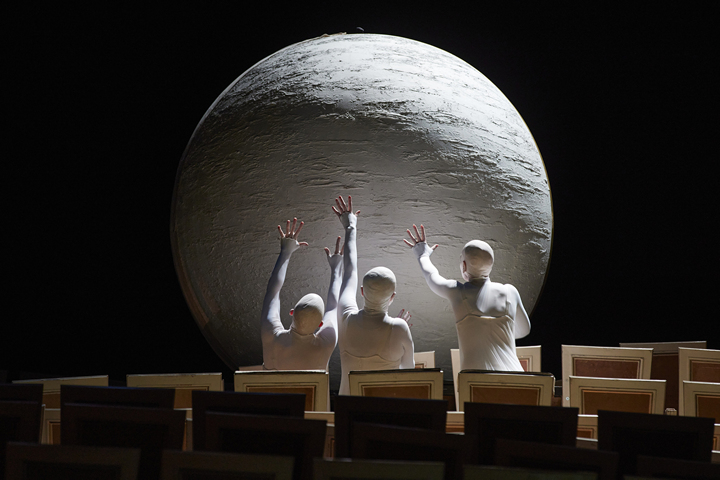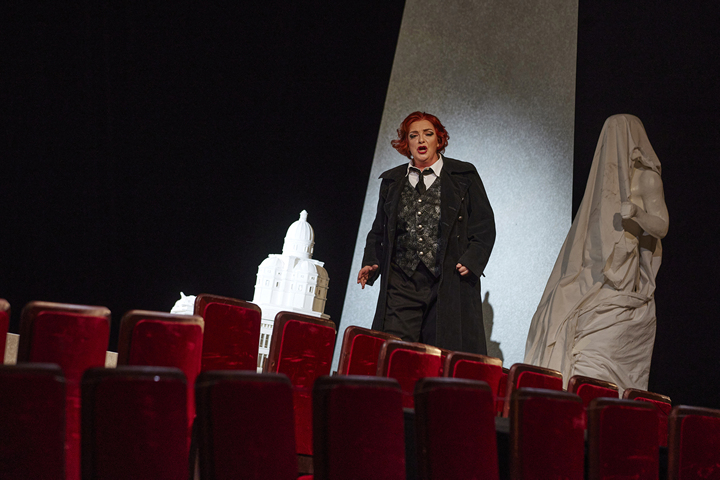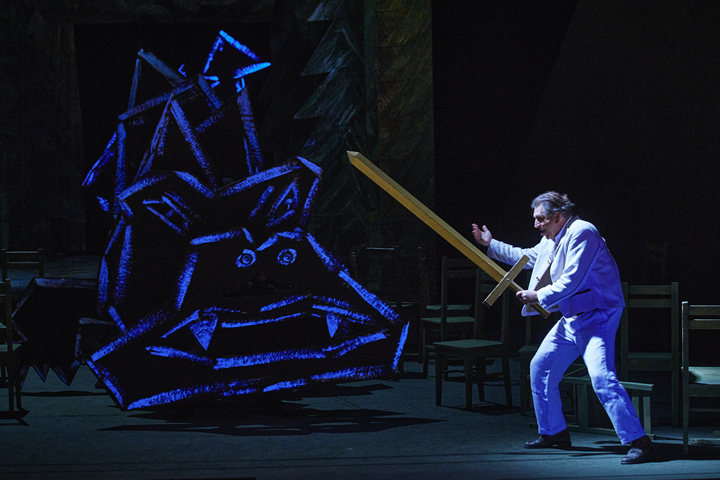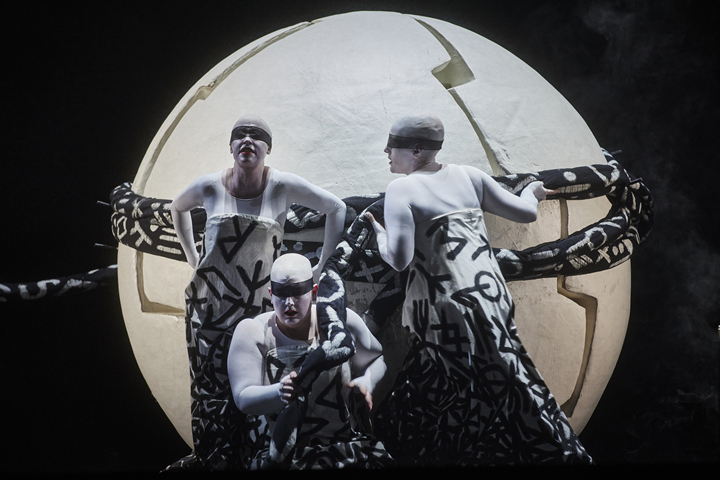| Opera Reviews | 27 July 2024 |
Wagner's epic work returns to the Semperoper stage for its very last showingby Tony Cooper |
|
Wagner: Der Ring des Nibelungen |
|

Das Rheingold - Lea-ann Dunbar (Woglinde), Anna Lapkovskaja (Flosshilde), Štěpánka Pučálková (Wellgunde)
|
|
|
Dresden harbours a special place in the history of the Ring as Wagner first thought about writing about the legend of the Nibelungen here while working in the city as Kapellmeister to the Saxon court. In fact, it was in Dresden that the first reading of the draft libretto took place. Therefore, revisiting Willy Decker’s Ring falls nicely into place after recently enjoying brand-new cycles in Berlin and Bayreuth over the past year. In fact, I last saw this production five years ago, so it was nice to be back in Dresden to take it in once again - and on its final outing. An iconic production, it was first seen in its entirety two decades ago. From an historical perspective, the Ring proper begins with Die Walküre and ends with Götterdämmerung while Wagner called Das Rheingold a ‘Vorabend’ or ‘Preliminary Evening’ with Die Walküre, Siegfried and Götterdämmerung subtitled 'First Day', 'Second Day' and 'Third Day'. The Semperoper follows suit in this respect by sticking to Wagner’s intentions in their publicity material. Willy Decker came up with a traditional, but very agreeable production teaming up with an old working colleague, set designer Wolfgang Gussmann, who created a host of economical, imaginative but spartan-looking sets, while costume designer, Frauke Schernau, turned out a stylish wardrobe for her godly clients. For example, the likes of Fricka and Freia were attired in smart two-piece black suits looking very business-like especially for their journey to Valhalla while long-flowing, aquamarine-coloured dresses perfectly fitted the characters of the Rhinemaidens. Enjoying a unique setting, the action of Decker’s Ring unfolded within a theatre auditorium thus creating a play within a play. Therefore, when the curtain went up on Das Rheingold the audience was greeted by row upon row of beige-coloured theatre-style seating covering the Semperoper’s entire stage arranged in a wave-like pattern clearly representing the fast-flowing waters of the Rhine. The trio of Rhinemaidens - Lea-ann Dunbar (Woglinde), Štěpánka Pučálková (Wellgunde) and Anna Lapkovskaja (Floßhilde) - performed well gliding round the stage in balletic fashion relating the tale of the Rhine’s secret treasure portrayed in this production by an enormous golden ball. And they captured well the empathy of their respective characters, too, while tantalising, teasing and debagging poor old Alberich to bursting point with their seductive and alluring charms. And when Wotan and his godly entourage sets off for their journey to Valhalla at the end of the opera, he’s proudly carrying a white-based architect’s model of his heavenly castle constructed in the style of a Greek classical temple with the ‘rainbow bridge’ created by a wide strip of grey-coated decking positioned above the theatre seats. It was left to Wagner’s richly-textured score to add the necessary colour to this most dignified scene. Interestingly, characters not involved in any stage action simply became members of the audience. Therefore, Loge, relaxed in a good stalls seat, seemed to be enjoying the moment witnessing Wotan moving house while the earth mother, Erda (sung regally and with such dignity by Michal Doron) caught a glimpse of him looking nervous and unsure of himself as he entered his newfound kingdom. Overall, the cast was splendid and on top form. Daniel Behle as Loge possessed a strong and authoritative tenor voice while making an electrically-charged stage entrance on a red-painted, fork-lightning prop lowered from the gridiron. Looking dapper and wrapped in a scarlet-red scarf, his whimsical mannerisms matched his pyrotechnical magic to the nth degree as befitting his fiery temperament. The role of Wotan was sung by Thomas J. Mayer to the right of the stage standing in for John Lundgren, and acted by Bernd Gierke, assistant director at the Semperoper. Christa Mayer, an intelligent and thoughtful singer, delivered a fine reading of Fricka standing up to Wotan, her aggressive, arrogant and wayward husband, in no uncertain terms while her sister, Jennifer Davis put in a confident performance as Freia. Markus Marquardt playing Alberich was aggressive, crafty and nasty as befits the role, laying into his long-suffering brother, Mime, nervously sung and acted by Jürgen Sacher. Playing the giants - Georg Zeppenfeld (Fasolt) and Stephen Milling (Fafner) hit the mark too, not just by their vocal prowess but by their presence as well. Padded out by baggy and oversized suits added the necessary weight and grit to their respective characters. They looked the part from head to foot while awkwardly striving and moving to the sound of big heavy chords to frightening effect. The minor, but colourful characters of thunderous Donner and spring-like Froh were dutifully and serenely sung by Lawson Anderson and Tansel Akzeybek.
|
|

Die Walküre - Ricarda Merbeth (Brünnhilde)
|
|
|
As the cycle progressed, the beige-coloured theatre seating used in Das Rheingold boldly gave way to a different permutation in Die Walküre inasmuch as the seats became flaming red set out in an arc-shaped formation which found Brünnhilde adorned, like the rest of her Valkyrie sisters, with flaming-red hair, tight fitting waistcoat and black trousers. Ricarda Merbeth, as Brünnhilde and Wotan (this time sung by Thomas J. Mayer on stage) performed brilliantly the scene of their parting and final farewell in the last act of the opera. A heart-wrenching moment, both singers put everything they had into this dramatic scene and the electricity between them was nothing but high voltage, coupled with extraordinary and powerful playing coming from the pit with Christian Thielemann in charge. It was exciting stuff down to the very last bar. However, the opening act of Die Walküre, calmer and quieter all round, saw Georg Zeppenfeld reappear on stage in the quizzical and suspicious role of Hunding attired in a smart tailored two-piece brown suit looking more like a bank manager than a forester. |
|

Siegfried - Andreas Schager (Siegfried)
|
|
|
Siegfried opened when the young hero burst in on Mime holed up in a scruffy and unkempt forest hut. It proved a well-constructed piece of comedic theatre. Clutching a large cuddly toy bear (the sort you win on a fairground coconut shy) he gave Mime the fright of his life, bundled up in a corner surrounded by a stack of old wooden chairs (Decker has got a thing about chairs!) chalking a blackboard trying to work out the equation to solve the problem of forging the sword Nothung with fragments of metal scattered all over the show highlighting his failed attempts in doing so. Creativity at its very best clicked in, though, for the forging of Nothung inasmuch as a three-sided set fell into place acting as the bellows while the fire, employed as throughout this fine production, was effective simply by good lighting effects. Jürgen Sacher flourished in the role of Mime lusting for ownership of the Nibelung ring. His characterisation of this creepy, Janus-faced creature, worked so well in tandem with the Siegfried of Andreas Schager who played his part innocently and to the full coming over in the usual way as a naïve, extravagant and unworldly youth. A busy boy, too, Schager also took on the role of Siegmund in Die Walküre with Allison Oakes as Sieglinde. Stephen Milling reached the depths of his solid bass voice as Fafner while the dragon - which, surely, would wow crowds at such world carnivals as Notting Hill - was operated by an eight-person team while Fafner’s den and the forest scene became squeezed into a large, squared, fairground-style booth. A rewarding role in Siegfried, the Woodbird was radiantly sung by Mirella Hagen off stage while young Hennes Neuber appeared on stage in a doppelgänger role as a young Siegfried constantly on the move and acting, in some respects, as a page to his master. And that delicate moment in which the Woodbird informs him about the whereabouts of his beautiful bride, was given a different angle by Decker who simply portrayed Brünnhilde wearing a flaming-red dress lying flat out on her back waiting for the hero of the hour. He was not far away. But where was the rock? Upon Brünnhilde’s grand reawakening she hails the sun and greets Siegfried as the World’s Light with Merbeth tenderly and radiantly singing ‘Heil dir, Sonne! Heil dir, Licht!’ while the loving couple join forces delivering a brilliant rendering of ‘Leuchtende Liebe, Lachender Tod!’ (Radiant Love! Laughing Death!) jubilantly and ecstatically confessing their true love for each other which romantically closes Siegfried on a high note. |
|

Götterdämmerung - Michal Doron, Kristina Stanek, Daniela Köhler (Nornen)
|
|
|
In Götterdämmerung, the roles of Gunther and Gutrune, generously played by Adrian Eröd and Anna Gabler, were seen enjoying the pleasures of life in the Gibichung Hall sipping champagne beside a large landscape-designed panelled window offering a romantic view of the Rhine valley so admired by generations of German writers and thinkers. A large globe dominated one side of the hall, a drinks table the other. Smartly attired in evening wear they looked uncomfortable within their home environment while Stephen Milling as Hagen, their half-brother and bogus marriage broker, constantly irritated Gutrune with sexual harassment. Waltraud Meier, one of the great Wagnerians of all time, sang Waltraute in Götterdämmerung with esteemed authority delivering a clear, poignant and sincere reading of this lovely and delicate role in which she energetically and nervously chivvies Brünnhilde to return the ring to the Rhinemaidens to save the Gods and mankind. But, of course, to no avail. However, the moment the Rhinemaidens recover the ring, it’s in a rather quiet and unassuming way and, indeed, a departure from the original libretto as Brünnhilde does not actually throw herself on Siegfried’s funeral pyre but simply gives back the troublesome ring to the Rhinemaidens with Wotan sneakily looking on. Gracefully, the daughters of the Rhine spend time adoring the ring entwined in a statuesque form in the style of Antonio Canova’s Neo-classical marble sculpture ‘The Three Graces’ looking joyously content and happy before descending to the Rhine’s deep waters. Brünnhilde, on the other hand, to cleanse the ring’s dreaded curse and to cleanse mankind, turns her back on treachery, deceit and betrayal that the ring brought upon its owners and just walks away from the melee. Another departure from the libretto witnesses Gutrune revenging her brother’s death by spearing Hagen to death, fighting for the ring to the bitter end, before collapsing herself within the panic, turmoil and confusion of the ending of the Gods and their beloved heavenly home, Valhalla. Overall, this was a strong and thoughtful production which left a lot to one’s imagination recalling Wagner’s statement that ‘imagination creates reality’. To give one example: in the tricky scene in Das Rhinegold where Alberich boasts to Wotan and Loge about the powers of the Tarnhelm, the magic helmet was depicted by a golden-coloured bowler-hat and the giant was simply portrayed by the hat being suspended in mid-air while the croaking toad was represented by the hat being hurriedly passed between Alberich and his two nosey visitors - a simple but very imaginative and straightforward piece of staging that worked well. But what goes on in the pit is just as important as to what happens on stage therefore full marks must go to Christian Thielemann, a great statesman for Wagner, for such outstanding work with the Staatskapelle Dresden, an orchestra that harbours some of the finest musicians to be found in Germany. Thielemann energised his charges so well in the big production numbers such as Siegfried’s ‘Rhine Journey’ and the ‘Funeral March’ in Götterdämmerung, but also in some of the exciting and shorter passages too, such as the thrilling and ecstatic opening bars that gets Die Walküre off to a blazing start while pulling out all stops for the famous ‘Ride of the Valkyries’ with eight French horns leading the ‘charge’. You expect the best at Dresden and that’s what one got. But as we all know, all good things must come to an end, therefore it’s all change at the Semperoper inasmuch as Decker’s Ring quietly bows out of the repertoire, a decision made by the Semperoper’s incoming Swiss-born director, Nora Schmid, who takes over from Peter Theiler from next season, while Thielemann bows out too as Principal Conductor of Staatskapelle Dresden at the end of the current season. I wonder where he’ll pop up next? I wonder, too, when the next Ring will rise from the ashes of Decker’s realisation. And another great Wagnerian, Waltraud Meier, made her final bow at Dresden after enjoying a brilliant and fulfilling career spanning 45 glorious years. She’s widely considered Germany’s most famous dramatic mezzo-soprano of the 20th and 21st centuries especially in the works of Richard Wagner and Richard Strauss. At the curtain call of Götterdämmerung, Thielemann delivered a short but unfussy speech, gave Meier a big hug and presented her with a large bouquet of flowers to wild and thunderous applause from a packed house who were thoroughly enjoying every minute of this special occasion. I’m pleased to say that I attended her farewell performance at Bayreuth in 2018 singing the role of Ortrud in Lohengrin, and being a member of the audience at the Semperoper for her final farewell to grand opera singing Waltraute in Götterdämmerung proved just the ticket! Bravissimo! |
|
| Text ©
Tony Cooper Photos © Semperoper Dresden / Ludwig Olah |
|







